Edit Properties Dialog Box
 Edit properties action is
available on both the DITA Maps Manager toolbar and in the contextual
menu. This action is also available in the contextual menu when you edit a DITA map document in
Author mode. The action opens the Edit
Properties dialog box and it includes several tabs with various functions and
fields that are initialized with values based upon the node where the action was
invoked.
Edit properties action is
available on both the DITA Maps Manager toolbar and in the contextual
menu. This action is also available in the contextual menu when you edit a DITA map document in
Author mode. The action opens the Edit
Properties dialog box and it includes several tabs with various functions and
fields that are initialized with values based upon the node where the action was
invoked. Edit properties action, only
the Profiling tab will be available and your modifications in that
tab will be applied to all the selected nodes. If you select multiple nodes that are not on
the same hierarchical level, the other tabs will also be available and your modifications
will be applied to the parent node (the child nodes will inherit the attributes of the
parent node).
Edit properties action, only
the Profiling tab will be available and your modifications in that
tab will be applied to all the selected nodes. If you select multiple nodes that are not on
the same hierarchical level, the other tabs will also be available and your modifications
will be applied to the parent node (the child nodes will inherit the attributes of the
parent node).You can use the Edit Properties dialog box to modify or define attributes, metadata, profiling, or keys in DITA maps or topics. You can also use it to modify the title of root maps.
At the top of the Edit Properties dialog box, the Reference type drop-down list displays the type of the selected node and it depends on the node where the action was invoked.
The main section of the dialog box includes the following tabs: Target, Keys, Attributes, Metadata, and Profiling. The availability of the tabs and their functions depend on the selected node. For example, if you invoke the action on a root map, only the Attributes, Metadata, and Profiling tabs are accessible and the Title property can be configured. Also, if you select multiple nodes, only the Profiling tab is available.
Target Tab
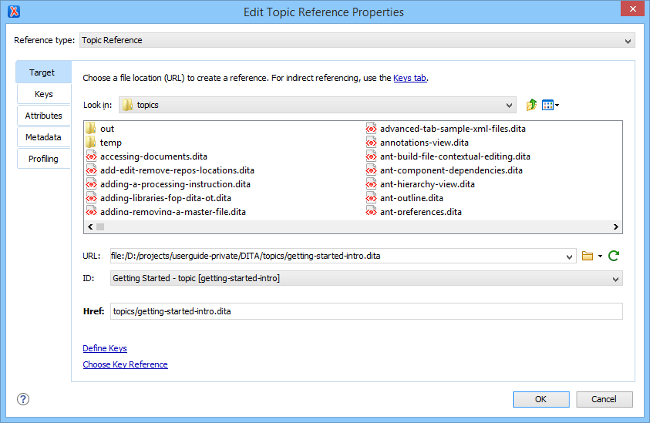
- Choose a file location section
- You can browse for and select the source target file by using the Look in drop-down list, browsing buttons, or file window in this section. You can use the Files of type drop-down menu to narrow the list of possible file types that will be displayed.
- URL
- Displays the path to the target and allows you to select or change it by using the combo box or browsing buttons.
- ID
- The drop-down list displays all of the target elements that are available for the selected target URL.
- Href
- The selected target automatically modifies this value to point to the corresponding
@hrefattribute of the target element.Note: If the Reference type is a Navigation Reference, the Href field is changed to Mapref, since a<navref>element requires a@maprefattribute instead.
Keys Tab
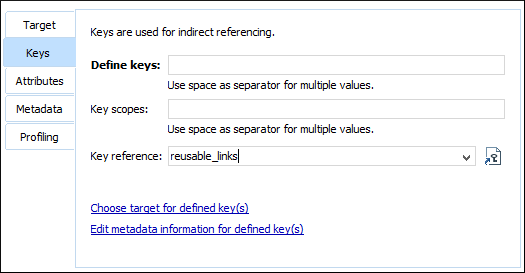
The Keys tab allows you to use and define keys for indirect referencing. For more information, see Working with Keys in DITA. This tab includes the following:
- Define keys
- Use this text field to define the
@keysattribute for the target. - Key scopes
- Use this text field to define or edit the value of a
@keyscopeattribute. Key scopes allow you to specify different sets of key definitions for different map branches. - Key reference
- Use this combo box (or the
 Choose
key reference button) to select a key that is already defined in the
root map.
Choose
key reference button) to select a key that is already defined in the
root map.
Attributes Tab

The Attributes tab of the Edit Properties dialog box allows you to insert and edit attribute values for the target node where the action was invoked.
If the target is a root map, the tab displays the title of the map. You can change it in the Title text field and assign it to an Attribute, Element, or All. However, if the title of the map contains elements other than plain text, the title is not editable and cannot be changed using this dialog box (you would need to open the DITA map in the main editor to edit the title).
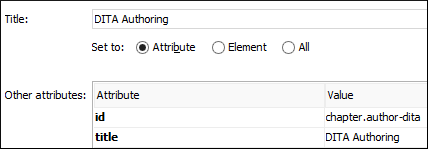
For other types of targets, the tab includes the following sections and fields that can be used to edit the attributes of the target:
- Navigation title
- Tip: You can also select the Prefer navigation title for topicref rendering option in the DITA preferences page to always enforce the use of the
@navtitlevalue rather than selecting this Lock option on individual topics. - Collection type
- This drop-down list allows you to select the
@collection-typeattribute to create hierarchical linking between topics in a DITA map (for example,unordered,sequence,choice,family,-dita-use-conref-target). - Type
- Allows you to select a
@typeattribute (such astopic,task,concept, etc.) for the target element. If you want this attribute to always be populated with a detected value (based on the specifications for the target file), select the Type checkbox for the Always fill values for attributes option in the DITA preferences page. - Scope
- This property corresponds to the
@scopeattribute of the target element. It is populated automatically, based on the selected file type, unless its value for the selected target file is the same as the default attribute value. If you want this attribute to always be populated with a detected value based on the specifications (regardless of the default value), select the Scope checkbox for the Always fill values for attributes option in the DITA preferences page. - Format
- This property corresponds to the
@formatattribute of the target element. It is populated automatically, based on the selected file type, unless its value for the selected target file is the same as the default attribute value. If you want this attribute to always be populated with a detected value based on the specifications (regardless of the default value), select the Format checkbox for the Always fill values for attributes option in the DITA preferences page. - Processing Role
- This drop-down list allows you to set the
@processing-roleattribute to one of the allowed values for DITA reference elements (for example,resource-only,normal,-dita-use-conref-target). - Other attributes table
-
This table contains the attributes that are available for the selected reference. You can use this table to insert or edit the values of any of the listed attributes. Clicking a cell in the Value column allows you to use the combo box to enter, edit, or select attribute values.
Metadata Tab
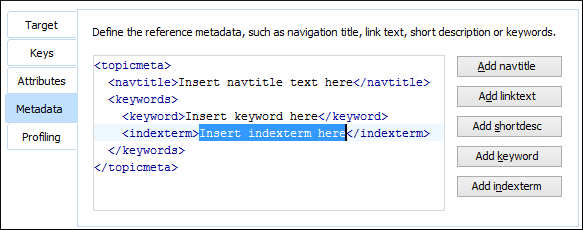
The Metadata tab allows you to add metadata elements to the target
node. Use the buttons on the right side of the tab to insert specific metadata
elements (you can add the following metadata elements: <navtitle>,
<linktext>, <shortdesc>,
<keyword>, <indexterm>). The metadata
elements are inserted inside a <topicmeta> element. The editing
window allows you to easily insert and modify the content of the metadata that will be
inserted.
Profiling Tab
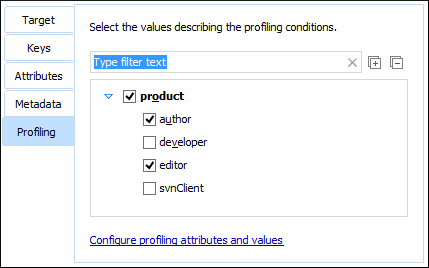
- If your root map references a DITA subject scheme map that defines values for the profiling attributes, those values are used.
- If your project defines project-level configuration values for the profiling attributes, those values are used.
- If Oxygen XML Editor defines global-level configuration values for the profiling attributes, they are used.
- Otherwise, a basic default set of profiling attributes and values are used.
If you have a large list of profiling attributes, you can use the text filter field to
search for attributes or values, and you can expand or collapse attributes by using the
 Expand All/
Expand All/ Collapse All buttons to the right of the
text filter or the arrow button to the left of the profiling attribute name.
Collapse All buttons to the right of the
text filter or the arrow button to the left of the profiling attribute name.
When you modify a selection of values in this tab, the change will also automatically be reflected in the Attributes tab. For more information, see DITA Profiling / Conditional Text.
 Edit
properties action on a selection of multiple nodes that have different values
for the same profiling attribute, a conflict panel will be displayed in the
Profiling tab and you can choose between the following actions for
resolving it:
Edit
properties action on a selection of multiple nodes that have different values
for the same profiling attribute, a conflict panel will be displayed in the
Profiling tab and you can choose between the following actions for
resolving it:- Keep - Preserves the current attribute values.
- Change Now - Allows you to edit the selection of values in this Profiling tab and the changes will be applied to all the selected nodes.

Finalizing Your Modifications
Once you click OK, all your changes are applied to the target node.
